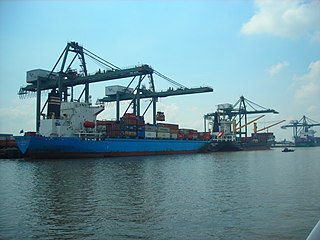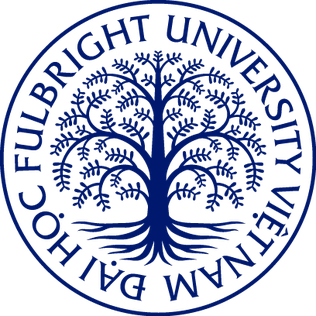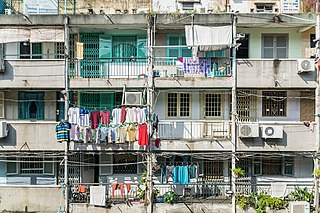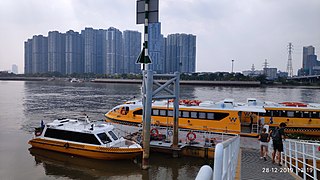
Transportation in Vietnam is improving rapidly in terms of both quantity and quality. Especially road traffic is growing rapidly but the major roads are dangerous and slow to travel on due to outdated design and an inappropriate traffic mix. In recent years, the construction of expressways has accelerated. Air travel is also important for long distance travel. Metro systems are under construction in the two metropolises of Vietnam, Hanoi and Ho Chi Minh City.

Ho Chi Minh City, formerly and still commonly known as Saigon, is the most populous city in Vietnam, with a population of around 9 million in 2019. Situated in the Southeast region of Vietnam, the city surrounds the Saigon River and covers about 2,061 km2 (796 sq mi).

The Saigon River is a river located in southern Vietnam that rises near Phum Daung in southeastern Cambodia, flows south and south-southeast for about 225 kilometres (140 mi) and empties into the Soài Rạp, which in its turn empties into the South China Sea some 20 kilometres (12 mi) northeast of the Mekong Delta.

Cơm tấm or com tam is a Vietnamese dish made from rice with fractured rice grains. Tấm refers to the broken rice grains, while cơm refers to cooked rice. Although there are varied names like cơm tấm Sài Gòn, particularly for Saigon, the main ingredients remain the same for most cases.

The Ho Chi Minh City Metro is a planned rapid transit network that will serve Ho Chi Minh City in Vietnam.

Le Van Tam Park, previously known as Mạc Đĩnh Chi Cemetery, is a park in Ho Chi Minh City, Vietnam. It formerly was a large and prestigious French colonial cemetery in South Vietnam, located near the US Embassy, Saigon. The cemetery had a wooded, bucolic setting, surrounded by a tall concrete wall, with a gated entrance on Hai Ba Trung Street. It originated as the burial ground for those killed during the 1859 battle for the Gia Dinh Citadel.

Fulbright University Vietnam (FUV) is a private nonprofit university currently located at the Crescent Plaza in Phú Mỹ Hưng in Hồ Chí Minh City, Vietnam. It is one of Vietnam's first private, nonprofit institutions of higher education. The FUV concept emerged from discussions convened by the Vietnam Program at the Harvard Kennedy School aimed at planning the next stage in the development of the Fulbright Economics Teaching Program (FETP), a center of public policy research and teaching in Hồ Chí Minh City.

The automotive industry in Vietnam is a fast-growing sector mainly reliant on domestic sales. All currently produced models are designed abroad by foreign brands, and many rely on knock-down kit production. Due to a high import taxes on automobiles, the Vietnamese government protects domestic manufacturing. Although Vietnam is a member of the ASEAN Free Trade Area, automobile imports fall under an exception. Since January 1, 2018, the 30% import tax has been discontinued as part of ASEAN agreements. Currently, the Vietnamese motor industry is not deemed competitive enough to make exports feasible. As of April 2018, 85% of car sales in Vietnam were produced domestically from CKD kits.

The manufacture and adoption of electric vehicles have been given preferential treatment by the Vietnamese government in order to reduce vehicle emission pollution. From March 1, 2022, battery powered cars will be exempt from registration fees for 3 years, along with subject to reduced excise taxes.
Saigoneer is a digital news site based in Ho Chi Minh City, Vietnam. Founded in 2012 by Brian Letwin and Alberto Prieto, Saigoneer hosts daily news reporting, original, and branded content in English, Vietnamese, and Korean. In January 2018, Saigoneer launched the Saigoneer Podcast, one of the first English podcasts produced in Vietnam.
Michael Tatarski is an American journalist based in Vietnam. Tatarski is the writer of Vietnam Weekly, and served as Editor-in-Chief of Saigoneer, a Ho Chi Minh City-based English news publication, from 2018 to 2022. Tatarski's reporting has covered Vietnamese culture, politics, and international relations, including the 2019 Trump-Kim Summit in Hanoi and the COVID-19 outbreak in Vietnam. He extensively covered Ho Chi Minh City's sidewalk clearing campaign, launched in 2018, and US-Vietnam relations.
Peter Cuong Franklin is a Vietnamese American chef and founder of Anan Saigon in Ho Chi Minh City, Vietnam, and Chôm Chôm in Hong Kong, specializing in "Cuisine Mới". Born in Da Lat, Vietnam, Franklin fled Ho Chi Minh City as a child refugee on April 29, 1975 during the Fall of Saigon. He was later adopted by an American family, attending Fairfield College Preparatory School and Yale University.

The Nguyen Thien Thuat apartment buildings are a complex of American-built historic buildings in District 3, Ho Chi Minh City. The apartments are located on Nguyen Thien Thuat street, a thoroughfare known for its musical instrument shops.
Dan Sinh Market, also known as American Market or Yersin Market, is a retail market in District 1, Ho Chi Minh City. Located on Yersin Street, the market is known for selling Vietnam War-era American memorabilia and military surplus.

The Saigon Waterbus is a transportation service in Ho Chi Minh City, Vietnam operating on the Saigon River. Launched in November 2017, the Waterbus offers services between District 1 and Thu Duc City. In 2021, the Waterbus launched an evening service from 5:00-9:00 PM.

The Ba Son Bridge, originally known as Thu Thiem 2 Bridge, is a 6-lane bridge in Ho Chi Minh City, Vietnam, opened in 2022. The bridge crosses the Saigon River to link District 1 and Thu Duc City.

Line 1 is rapid transit line of the Ho Chi Minh City Metro, Vietnam. Line 1 is the city's first metro line, connecting District 1 and Thu Duc City. The line began construction in 2012, initially scheduled for completion in 2018. The project's completion date has been delayed to the end of 2023. Ticket prices will range from VND9,000-23,000 ($0.39-1) per trip.

Ben Thanh Station is a future underground Ho Chi Minh City Metro interchange station on the future Line 1, Line 2, Line 3A, and Line 4A. Located in front of Ben Thanh Market, the station will serve as the central metro station in Ho Chi Minh City, Vietnam.
Opera House Station is a future underground Ho Chi Minh City Metro station on Line 1. Built in front of the Municipal Theatre of Ho Chi Minh City, the station opened to public viewing in April 2020. It is expected to be completed in by the end of 2023 before public operations begin in early 2024.

The Nhieu Loc-Thi Nghe Canal is a canal in Ho Chi Minh City, Vietnam. The 9 km long canal passes through Districts 1, 3, Phu Nhuan, Tan Binh and Binh Thanh and flows into the Saigon River.















